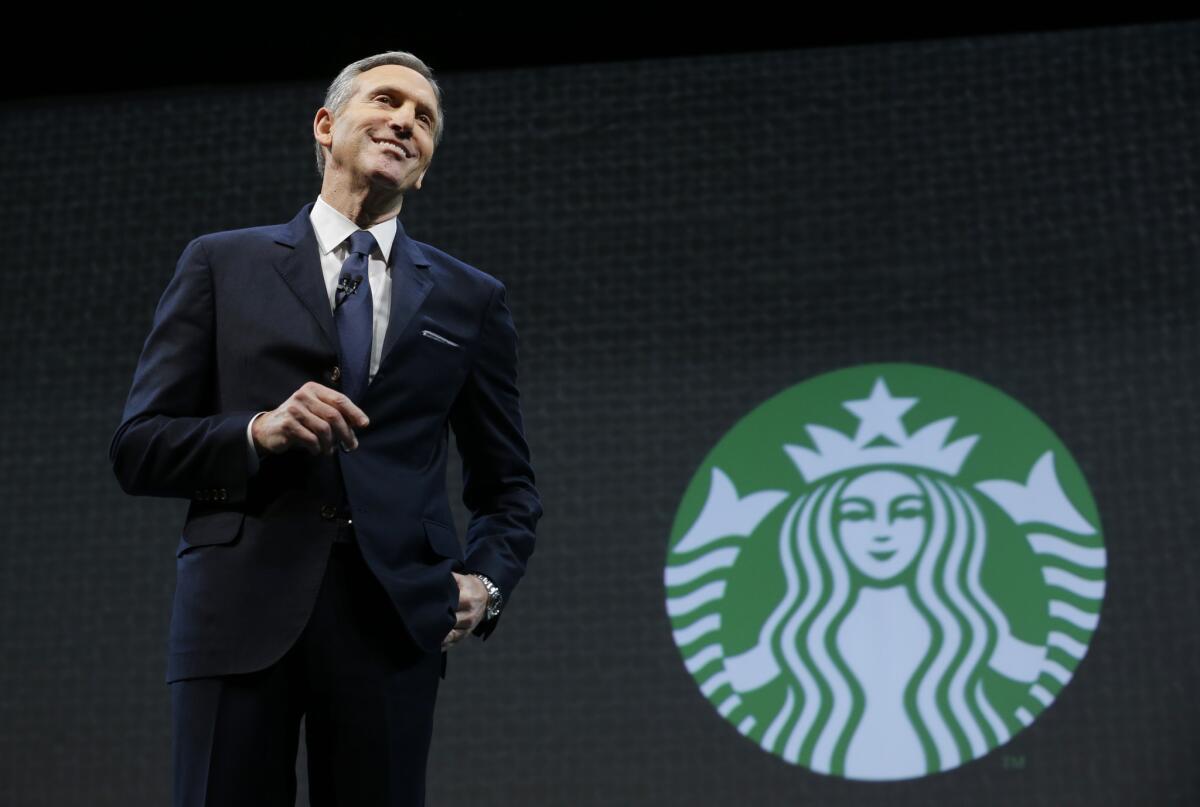Don’t praise Starbucks for moving its water bottling out of California

Starbucks founder and CEO
- Share via
Starbucks scored an enviable publicity coup last week by announcing that it was moving the bottling of its store brand of bottled water, Ethos, out of drought-stricken California and over to Pennsylvania.
The company described the move as consonant with “our mission to be a globally responsible company” and a way of standing fast with the people of California in the teeth of “this unprecedented drought.”
But it should be seen as something else: an example of how a corporation seems to be doing something to solve a problem, without really accomplishing much at all. Let’s examine why.
To begin with, as we reported recently, on a statewide basis the bottling of water isn’t a major factor in the drought. Bottled water sales nationwide--from all sources and in all markets--comes to about 10 billion gallons per year; California’s statewide water usage is 38 billion gallons per day.
Water bottling plants could, however, have localized effects on groundwater availability and quality. That could be the case in Merced, where the plant that supplied Ethos with water for its western regional sales is. It’s been a concern among locals there during the drought.
We can’t know the effect, however, because the quantity of water produced by the plant is a secret between the plant, which is operated by Safeway, the grocery company, and the city of Merced. Starbucks might have accomplished much more by agitating for the disclosure, not only in Merced but statewide, of bottling plant outputs. But that would interfere with its commercial relationships, and we can’t have that.
In any event, it’s unclear whether Starbucks’ withdrawing its business will have any effect on bottling output from the plant, or whether Safeway will be able simply to make up the difference by sales to other clients.
What does seem likely, in any case, is that Starbucks’ action will increase the environmental footprint of its water sales, since Ethos will have to ship water to its western locations all the way from far-off Pennsylvania instead of nearby Merced. Starbucks said it will look for a new supplier for the western region, but didn’t offer a timeline.
In any case, the company’s Pennsylvania source is itself facing drought conditions, though not as badly as California. That points to the broader reality of water supply: It’s getting scarcer everywhere, and one factor is the increasingly intense marketing of bottled water.
Starbucks is part of this problem, and its relocation of Ethos bottling out of California is in no way a solution. The rise of bottled water reflects what Peter Gleick, president and co-founder of the Pacific Institute, describes as the “war on tap water” in his book “Bottled and Sold: The Story Behind Our Obsession with Bottled Water.”
“We’ve turned to the bottle,” he writes, “convinced that paying a thousand times more for individually packaged plastic throwaway containers of water than for readily available tap water is an act of rationality rather than economic, environmental, and social blindness.” Bottled water carries enormous costs in energy, oil, and water consumption in manufacturing those bottles and shipping them as far as halfway around the world. (Hello, Fiji Water.)
The bottled-water industry has fueled its rapid growth in part by slandering tap water systems, which in many cases are cleaner and safer than the bottling sources. In his book, Gleick describes the difficulty he ran into trying to obtain the record of a 4.1-million-bottle recall of contaminated water in 2005 by, yes, Ethos--a recall that wasn’t disclosed until nine months later, when Gleick unearthed it from the FDA through multiple Freedom of Information requests.
Starbucks, again, could strike a bigger blow for environmental responsibility by ceasing all bottled water sales in its stores--though that might cut into its bottom line, since it acquired Ethos from its entrepreneurial founders in 2005.
It could start by equipping its locations with water fountains, which as Gleick observes have become scarcer in public places since the rise of the bottling industry. There weren’t any at either of the Starbucks I visited this week in my neighborhood (though the baristas graciously offered to fill my water bottle from behind the counter). Virtually 100% of Starbucks’ barista-prepared drinks are water, drawn from the tap and filtered and purified on-site--surely it’s safe enough to pipe to customers straight-up.
But as Gleick observes, we’ve been trained through advertising and marketing to think of bottled water as something special. Ethos itself is built around a marketing scheme. For every bottle bought, the company donates five cents to a fund to “support water, sanitation and hygiene education programs in water-stressed countries.” This is known as “social marketing,” but the focus should be on the “marketing,” not the “social.” For this is an effort to dress up a bad business.
Starbucks says its purchase of Ethos was part of an effort “to help address the global humanitarian water crisis,” but that’s preposterous. It could achieve much more by withdrawing from the business of overpriced, environmentally destructive bottled water entirely. Short of that, its valiant step of moving its supply out the California drought zone deserves the applause of one hand clapping.
Keep up to date with the Economy Hub. Follow @hiltzikm on Twitter, see our Facebook page, or email mhiltzik@latimes.com.
More to Read
Inside the business of entertainment
The Wide Shot brings you news, analysis and insights on everything from streaming wars to production — and what it all means for the future.
You may occasionally receive promotional content from the Los Angeles Times.










